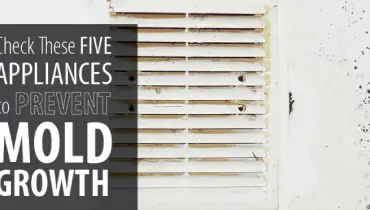
Preventing mold growth starts with regular appliance maintenance. Rainbow Restoration highlights key appliances to monitor for moisture issues.
|
Naturally occurring, mold is everywhere, growing just about anywhere excess moisture is present. So how do you prevent mold in your home? The good news is, that proper cleaning, along with the monitoring of humidity levels in your home, can help you control and prevent mold growth.
Check these five appliances to make sure they aren't causing mold growth
- AC vents Although uncommon, mold can grow in air ducts. Looking for visual signs of mold by peering inside your vents is the easiest way to find it. If that fails you, your nose is the second-best indicator. If you can’t see or smell it, you should be alright, but for those who want to be 100% sure, a trusted mold remediation service professional can test for mold.
- Water heater Typically tucked away in closets or the dark corners of utility rooms, water heaters can cause a lot of mold damage after unknown leaks. Large leaks make themselves present with obvious puddles, however, mold on the floor and walls around your water heater may indicate a slow leak (or other issue). To prevent the spread of mold and further destruction to building materials, promptly replace the water heater or address the leak and moldy materials.
- Washing machines Open your front-loader to be knocked over by a blast of musty air. The watertight design of these machines creates the perfect environment for housing mold and mildew. Keep it smelling fresh and clean by regularly cleaning the gasket with hot soapy water, and doing the same with detergent dispensers. Then run an empty wash cycle using hot water and a cup of bleach OR baking soda. If it still smells, you may have mold hiding behind the drum, a clogged drain, or a filter, which will require professional attention.
- Refrigerators Musty odors in the fridge? Kick ‘em to the curb with a solution of 1 tbsp baking soda, a natural fungicide, to 1 quart of warm water. After you clean out your refrigerator’s contents, thoroughly wipe down walls, floors, and ceilings –don’t forget the crevices of that nasty gasket around the door. Remove and clean bins and shelves as well, using caution with glass surfaces, which may scratch. Repeat the process with a fresh rag and warm water to rinse. Don’t overlook your freezer!
- Humidifiers Even newer humidifier models dubbed “antimicrobial” require daily cleaning. Each day, before you refill, empty, rinse, and dry the base. Once a week, remove the scale with vinegar, then disinfect it as per manufacturer instructions. Always de-scale and disinfect before and after storage.
Can My Thermostat Help Me Control Mold Growth?
What is the best temperature for mold to grow? Molds prefer the same temperatures as you and your family, but also like yourselves, can survive cold environments. Thus, it is not possible to control or eliminate mold growth with temperature regulation.
But It’s on My Walls…
Remember, mold requires moisture to grow, so if you want to know how to stop mold from growing on walls, start here, investing in a $20 digital temperature and relative humidity (RH) sensor. Have the mold on your walls professionally removed, and aim to keep your home below 70-75% RH most of the day. If you cannot, you may need improved ventilation or a dehumidification system in your home.
Can Black Mold Grow on Plastic?
Stachybotrys chartarum, also known as Stachybotrys atra or mycotoxin-producing “black mold,” cannot grow on plastic, vinyl, concrete, or ceramic, such as shower tile. Instead, it favors materials with high fiber and low nitrogen content, such as wallboard, paper, and wood.
Feeling a Little Green?
It’s important to remove any mold found in your home thoroughly – as soon as possible. Mold exposure is attributable to a host of health issues, from allergies and asthma to bronchitis and pneumonia and even chronic fatigue, digestive issues, and depression.
Musty odors in your home? Identify and remove dangerous mold growth in your home with the expert help of Rainbow Restoration®. Contact us today.
